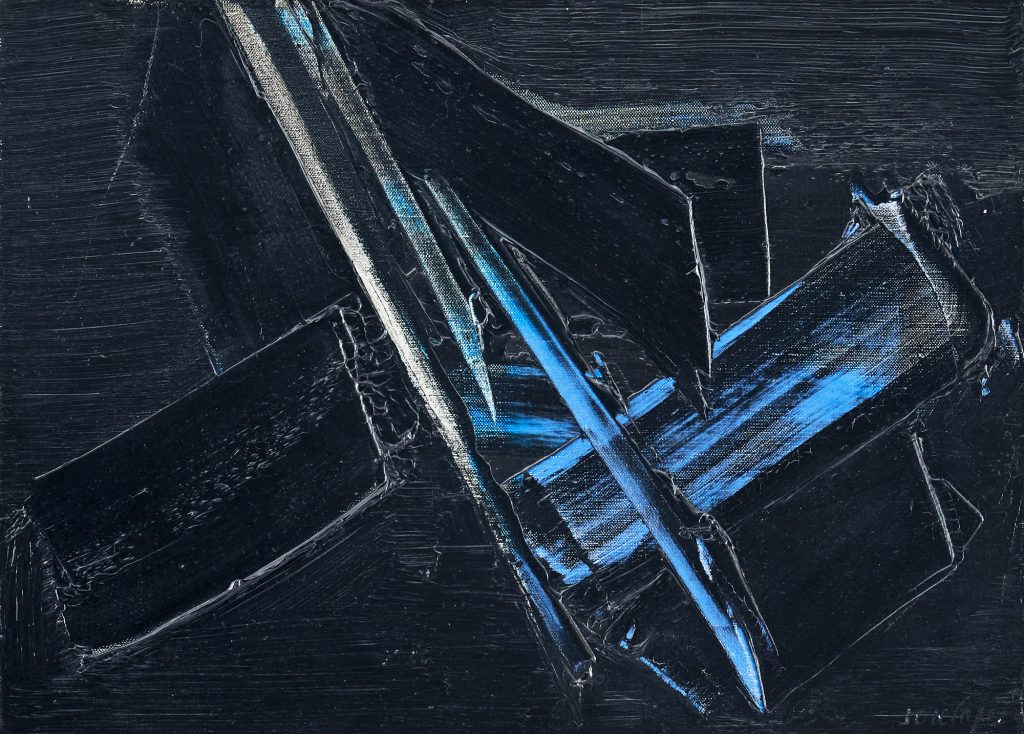”Peinture 33 x 46 cm, 8 septembre 1959” by Pierre Soulages

370. Pierre Soulages (France born 1919). ”Peinture 33 x 46 cm, 8 septembre 1959”. Signed Soulages and signed and dated Soulages 8 sept 1959 on reverse. Oil on canvas, 33 x 46 cm.
SEK 1.200.000 – 1.500.000 € 114.000 – 142.000
Provenance:
The collection of art collector and art dealer Sir Rex de Charembac Nan Kivell (1898‑1977), London.
The collection of Ingeborg von Rosen (born Pineus) (1901‑1986), Stockholm.
A Swedish Private Collection, acquired from the above.
Literature:
Pierre Encrevé, Soulages: L’oeuvre complet: peintures, volume II, no. 387, illustrated p. 56 (dated 6 septembre 1959 in the catalogue).
IN CONTEXT
Pierre Soulages is recognised as one of the major figures of abstract art and his intriguing works are held in many of the most prestigious public and private collections worldwide. The former president of France François Hollande described Pierre Soulages in 2014 as ”the world’s greatest living artist”, referring to his incredible creative energy and outstanding artistic expression.
Soulages spent most of his childhood drawing with black ink, as he was born into a family of modest means and his mother could not afford to buy him coloured crayons. Known today as “the painter of black and light”, Soulages has continued to use the power of black through his entire career and induced light in his paintings with shades of blue. According to Soulages, the colour blue represents light or as the Danish art historian Andrea Rygg Karberg phrased it in her exhibition catalogue for “Pierre Soulages – Painting the light” in 2006: ”Soulages makes the blue colour shine – because the blue is intensified by black, or because a bright ground shines through the blue”. In the 1950’s, azure began to dominate his works but by the end of the decade his palette darkened to deep black. “Peinture 33 x 46 cm, 8 septembre 1959”, included in this sale, was executed just before the blue colour disappeared in his canvases and dates from a significant period in the artist’s fascinating career. There is a fine balance between order and disorder in this vivid composition, maintained through the influence of the contrasting blue and white being so intense that the space of the canvas almost seems to be equally distributed between the colours. The elongated shades of blue and white blending together with the black creates an intense atmosphere radiating with energy and motion typical for works of Soulages dating from the late 1950’s. Soulages aimed for his canvases to exist on the surface and formed ridges around each swath with his soft palette knife without restricting the paint. Instead, he anticipated the reactions of the material.
Soulages’ paintings of the 1950’s are among his most sought after and are dominated by increasingly powerful sweeps of paint and a growing luminosity, resulting in stunningly intriguing and dramatic works of art. Visible wide brushstrokes lie diagonally across the image and overlap transverse finer lines, creating an irregular pattern full of presence and depth. By creating a completely diagonal construction the gaze of the viewer is immediately drawn sideways. Soulages’ abiding fascination for form over illusion is well exemplified in “Peinture 33 x 46 cm, 8 septembre 1959”, relating to one of his earliest inspirations of the dramatic silhouettes of bare branches against the sky. His interest for painting abstract patterns of crossing vertical and horizontal lines derived from the tree and he began to paint them from the age of seven. In Bernard Ceysson’s Soulages, the artist recalls: “Was my childhood fondness for bare trees due to my love of black as a colour? Or was it the other way round? Did I begin to love black because of the trees in winter without their leaves; because of the way the black trunks and branches stood out against the background of sky or snow, making them look brighter by contrast…”
The decade of the 1950’s was an intense period for Pierre Soulages, years marked by several important exhibitions worldwide from which he received increasing international recognition as one of the leading pioneers of abstract painting. In 1952 he exhibited his works at the Venice Biennale and the following year he took part in his first group exhibition at the Salomon R. Guggenheim Museum in New York. The same year “Peinture 33 x 46 cm, 8 septembre 1959” was executed, his works were exhibited once again in a group show at the Guggenheim Museum. When Soulages first showed his works in America in the early 1950’s, many associated his abstract compositions with those of the American abstract expressionist Franz Kline. There are striking similarities between the works by Kline and Soulages, however the finished effect and the process behind their art mark clear differences. Kline often used sketches before he created the final compositions, whereas Soulages finds his inspiration in the moment before every work of art. Throughout his career, Soulages has refused to place his works in a certain category, style or even historical context, allowing his paintings to convey an objective beauty and meaning. In a conversation with Michael Peppiatt in Art International in 1980, Soulages declared: “I don’t depict. I don’t narrate. I don’t represent. I paint. I present.”
“Peinture 33 x 46 cm, 8 septembre 1959” was previously in the collection of Sir Rex de Charembac Nan Kivell, a British art collector famous for his involvement with the Redfern Gallery in London from 1925. Nan Kivell was a successful collector with an unusual talent for discovering gifted artists, and through the Redfern Gallery he managed to establish many British artists as well as to introduce important European artists to England. Ingeborg von Rosen, born Pineus and the daughter of the prominent art collector and businessman Conrad M. Pineus, most probably acquired the painting directly from Nan Kivell. The painting has ever since remained in private collection.